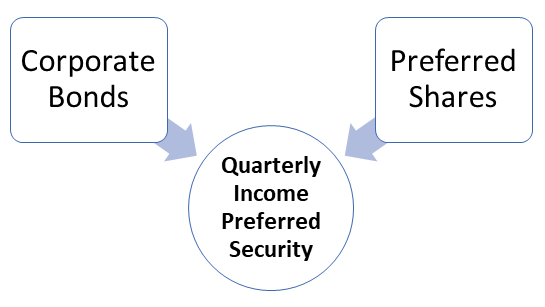What is Quarterly Income Preferred Securities (QUIPS)?
Quarterly income preferred securities (QUIPS) is a hybrid form of preferred stocks. These securities represent an ownership stake in the companies or limited partnerships whose core operation is to issue these securities and lend the amount generated from the QUIPS to the parent company.
Usually, the par value of the QUIPS is $25 on the New York Stocks Exchange (NYSE) and the distribution of income is done on a quarterly basis.
Goldman, Sachs & Co. introduced QUIPS as a tool for marketing. QUIPS is hybrid security as it has the features of both corporate bonds and preferred stocks. Like bonds, QUIPS have par value and maturity date. In addition, like preferred stocks, QUIPS have an ownership stake in the partnership or limited company, the dividend payment is done on a quarterly basis, and they are listed on the stocks exchanges as well.
Highlights
- Quarterly Income Preferred Security (QUIPS) is a hybrid form of preferred stocks.
- QUIPS represent an ownership stake in the companies or limited partnerships whose core operation is to issue these securities and lend the amount generated from the QUIPS to the parent company.
- QUIPS is a hybrid of preferred shares and corporate bonds.
Frequently Asked Questions (FAQs)
What is the significance of the QUIPS?
QUIPS are subordinate debts that look like the preferred stocks and are issued by the parent companies. Technically, subsidiary companies issue the QUIPS and lend the amount to the parent company. It can also be interpreted as the parent company is taking a loan from the subsidiary company; therefore, the parent company can deduct the interest payment while filing tax returns.
It is important to acknowledge that the issuer can defer or suspend the dividend payment, which is interest payment in the case of QUIPS. This risk has to be considered by the investors before making the investment decision. The structure of the QUIPS does not increase the debt level of the parent company, and therefore, the debt ratio cannot be jeopardised.

Source: Copyright © 2021 Kalkine Media
What is the working of QUIPS?
QUIPS are issued by domestic or foreign limited liability companies or limited partnership companies whose core area of operations is to issue this security. Irrespective of the company’s location, nationality or structure, the issuing entity is a wholly-owned subsidiary of the US enterprise. These companies are not engaged in any financial operations like making a portfolio, making investments on behalf of clients, or financing other businesses. The parent company solely creates these entities to issue the shares on behalf of the parent company.
Funds are raised by the limited partnership or company and use the funds to loan it to the parent company. In exchange for the loan amount, the parent company pays the interest to the subsidiary company and the subsidiary company uses the amount for paying the dividends to the QUIPS holders on a quarterly basis. The issuing and parent companies are partners; therefore, the interest payment flows to the QUIPS holders. Corporate taxes are not paid first; else it will be considered as regular dividend-paying stocks.
From the technical aspect, the parent company is taking a loan from the subsidiary company on which the company pays interest. Therefore, the parent company deducts the interest paid while filling the tax returns.
What is the concept of maturity dates in QUIPS?
QUIPS have a limited lifespan, just like bonds, even though they are traded on the listed stocks exchanges. The maturity period of QUIPS ranges from 30 to 50 years. The lifespan of the QUIPS can be extended as the issuers have the right to extend them in some cases. For instance, a renowned telecom provider issued QUIPS with a maturity period of 30 years and afterwards extended the maturity period to 49 years. There was another QUIPS issuer that reduced the maturity period from 30 years to 5 years of non-callable period.
It is important to note that, as the majority of the hybrid securities, the average maturity cycle of QUIPS is 40 years.
What benefits and disadvantages are associated with QUIPS?
QUIPS create a win-win situation for both the issuer and the investors as the company gets to enjoy the inflow of cash and the investors receive a steady income stream.
Another advantage that the parent company enjoys is that the structure of the QUIPS benefits the company. The debt level of the company remains steady, and the debt ratio is also not jeopardised.
There is a risk factor while investing in QUIPS. The issuing company can defer the dividend payment for a particular quarter which is an interest payment for the parent company. It should not be considered a default on the issuing company's part as the parent company might not have paid the interest. If the dividend is not paid as per the promised date, the investors have no right to push the company into court for filing the bankruptcy case.

Source: © Prawny | Megapixl.com
What financial instruments are similar to QUIPS?
TruPS and Quarterly Income Debt Securities (QUIDS) are two financial instruments that are similar to QUIPS.
TruPS stands for the Trust Preferred Securities issued by the trust instead of the wholly owned subsidiary entity. The investors receive preferred shares of the trust.
QUIDS (Quarterly Income Debt Securities) is an unsecured debt that has long maturities with smaller denominations. The par value of QUIDS is $25 with the maturity of 30 years and cannot be called before five years. Like QUIPS, QUIDS are also issued by the subsidiary company and proceeds are lend to the parent company. The only difference between QUIDS and QUIPS is that interest payment on QUIDS is included in the tax calculation before the payment.
There is a very small difference between these three instruments. Therefore, an investor should have in-depth knowledge of the differences and invest accordingly.
 Please wait processing your request...
Please wait processing your request...